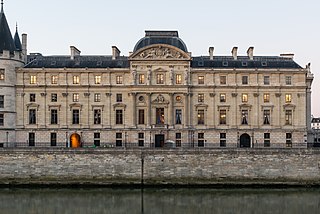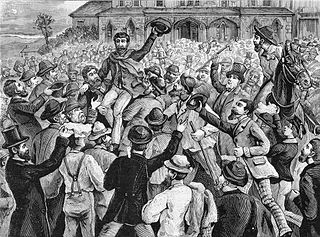Related Research Articles

Common law is the body of law primarily developed through judicial decisions rather than statutes. Although common law may incorporate certain statutes, it is largely based on precedent—judicial rulings made in previous similar cases. The presiding judge determines which precedents to apply in deciding each new case.
In jurisprudence, double jeopardy is a procedural defence that prevents an accused person from being tried again on the same charges following an acquittal or conviction and in rare cases prosecutorial and/or judge misconduct in the same jurisdiction. Double jeopardy is a common concept in criminal law – in civil law, a similar concept is that of res judicata. The double jeopardy protection in criminal prosecutions bars only an identical prosecution for the same offence except when the defendant is a servicemember as the courts have ruled that the military courts are a separate sovereign, therefore servicemembers can be held in two separate trials for exactly the same charges; however, a different offence may be charged on identical evidence at a second trial. Res judicata protection is stronger – it precludes any causes of action or claims that arise from a previously litigated subject matter.
In the United States, a state court is a law court with jurisdiction over disputes with some connection to a U.S. state. State courts handle the vast majority of civil and criminal cases in the United States; the United States federal courts are far smaller in terms of both personnel and caseload, and handle different types of cases. States often provide their trial courts with general jurisdiction and state trial courts regularly have concurrent jurisdiction with federal courts. Federal courts are courts of limited jurisdiction and their subject-matter jurisdiction arises only under federal law.

The United States courts of appeals are the intermediate appellate courts of the United States federal judiciary. They hear appeals of cases from the United States district courts and some U.S. administrative agencies, and their decisions can be appealed to the Supreme Court of the United States. The courts of appeals are divided into 13 "Circuits". Eleven of the circuits are numbered "First" through "Eleventh" and cover geographic areas of the United States and hear appeals from the U.S. district courts within their borders. The District of Columbia Circuit covers only Washington, DC. The Federal Circuit hears appeals from federal courts across the entire United States in cases involving certain specialized areas of law.

The United States district courts are the trial courts of the U.S. federal judiciary. There is one district court for each federal judicial district. Each district covers one U.S. state or a portion of a state. There is at least one federal courthouse in each district, and many districts have more than one. District court decisions are appealed to the U.S. court of appeals for the circuit in which they reside, except for certain specialized cases that are appealed to the U.S. Court of Appeals for the Federal Circuit or directly to the U.S. Supreme Court.

The United Kingdom has three distinctly different legal systems, each of which derives from a particular geographical area for a variety of historical reasons: English law, Scots law, Northern Ireland law, and, since 2007, calls for a fourth type, that of purely Welsh law as a result of Welsh devolution, with further calls for a Welsh justice system.

The Court of Cassation is the supreme court for civil and criminal cases in France. It is one of the country's four superior courts, along with the Council of State, the Constitutional Council and the Jurisdictional Disputes Tribunal.

In common law jurisdictions, an acquittal means that the criminal prosecution has failed to prove that the accused is guilty beyond a reasonable doubt of the charge presented. It certifies that the accused is free from the charge of an offense, as far as criminal law is concerned. The finality of an acquittal is dependent on the jurisdiction. In some countries, such as the United States, an acquittal prohibits the retrial of the accused for the same offense, even if new evidence surfaces that further implicates the accused. The effect of an acquittal on criminal proceedings is the same whether it results from a jury verdict or results from the operation of some other rule that discharges the accused. In other countries, like Australia and the UK, the prosecuting authority may appeal an acquittal similar to how a defendant may appeal a conviction — but usually only if new and compelling evidence comes to light or the accused has interfered with or intimidated a juror or witness.

In law, a verdict is the formal finding of fact made by a jury on matters or questions submitted to the jury by a judge. In a bench trial, the judge's decision near the end of the trial is simply referred to as a finding. In England and Wales, a coroner's findings used to be called verdicts but are, since 2009, called conclusions.
In criminal law, a sentence is the punishment for a crime ordered by a trial court after conviction in a criminal procedure, normally at the conclusion of a trial. A sentence may consist of imprisonment, a fine, or other sanctions. Sentences for multiple crimes may be a concurrent sentence, where sentences of imprisonment are all served together at the same time, or a consecutive sentence, in which the period of imprisonment is the sum of all sentences served one after the other. Additional sentences include intermediate, which allows an inmate to be free for about 8 hours a day for work purposes; determinate, which is fixed on a number of days, months, or years; and indeterminate or bifurcated, which mandates the minimum period be served in an institutional setting such as a prison followed by street time period of parole, supervised release or probation until the total sentence is completed.
The court system of Canada is made up of many courts differing in levels of legal superiority and separated by jurisdiction. In the courts, the judiciary interpret and apply the law of Canada. Some of the courts are federal in nature, while others are provincial or territorial.
The federal judiciary of the United States is one of the three branches of the federal government of the United States organized under the United States Constitution and laws of the federal government. The U.S. federal judiciary consists primarily of the U.S. Supreme Court, the U.S. Courts of Appeals, and the U.S. District Courts. It also includes a variety of other lesser federal tribunals.
A new trial or retrial is a recurrence of a court case. A new trial may potentially be ordered for some or all of the matters at issue in the original trial. Depending upon the rules of the jurisdiction and the decision of the court that ordered the new trial, a new trial may occur if:

The High Court of Singapore is the lower division of the Supreme Court of Singapore, the upper division being the Court of Appeal. The High Court consists of the chief justice and the judges of the High Court. Judicial Commissioners are often appointed to assist with the Court's caseload. There are two specialist commercial courts, the Admiralty Court and the Intellectual Property Court, and a number of judges are designated to hear arbitration-related matters and insolvency matters respectively. In 2014 the Family Division of the High Court was created, and in 2015 the Singapore International Commercial Court ("SICC") was established as a division of the High Court. The current divisions of the High Court are the General Division and the Appellate Division. The seat of the High Court is the Supreme Court Building.

The Court of Appeal of Singapore is the highest court in the judicial system of Singapore. It is the upper division of the Supreme Court of Singapore, the lower being the High Court. The Court of Appeal consists of the chief justice, who is the president of the Court, and the judges of the Court of Appeal. The chief justice may ask judges of the High Court to sit as members of the Court of Appeal to hear particular cases. The seat of the Court of Appeal is the Supreme Court Building.

In most legal jurisdictions, a supreme court, also known as a court of last resort, apex court, and highcourt of appeal, and court of final appeal, is the highest court within the hierarchy of courts. Broadly speaking, the decisions of a supreme court are binding on all other courts in a nation and are not subject to further review by any other court. Supreme courts typically function primarily as appellate courts, hearing appeals from decisions of lower trial courts, or from intermediate-level appellate courts. A supreme court can also, in certain circumstances, act as a court of original jurisdiction.
The Double Jeopardy Clause of the Fifth Amendment to the United States Constitution provides: "[N]or shall any person be subject for the same offence to be twice put in jeopardy of life or limb..." The four essential protections included are prohibitions against, for the same offense:
Estelle v. Williams, 425 U.S. 501 (1976), is a Supreme Court case involving Harry Lee Williams' conviction of assault on his former landlord in Harris County, Texas. While awaiting trial Williams was unable to post bail. He was tried in his prison uniform, and later was found guilty. He sought a writ of habeas corpus saying being tried in a prison uniform violated his Constitutional rights in accordance with the 14th Amendment. The Court of Appeals ruled that the accused does not have to stand trial in identifiable prison clothes and Williams’ right to due process was violated. The Supreme Court reversed, reinstating the conviction, on June 21, 1976.
Nix v. Williams, 467 U.S. 431 (1984), was a U.S. Supreme Court case that created an "inevitable discovery" exception to the exclusionary rule. The exclusionary rule makes most evidence gathered through violations of the Fourth Amendment to the United States Constitution, which protects against unreasonable search and seizure, inadmissible in criminal trials as "fruit of the poisonous tree". In Nix, the Court ruled that evidence that would inevitably have been discovered by law enforcement through legal means remained admissible.
References
- 1 2 3 4 5 Wilkes, Daniel (27 October 2009). "Law for special environments: ice islands and questions raised by the T-3 case". Polar Record. 16 (100): 23–27. doi:10.1017/S0032247400062392. S2CID 129713443.
- 1 2 3 4 5 6 7 Wilkes, Daniel (27 October 2009). "Law for special environments: jurisdiction over polar activities". Polar Record. 16 (104): 701–705. doi:10.1017/S0032247400063646. S2CID 128981257.
- 1 2 3 Pharand, Donat (1971). "State Jurisdiction over Ice Island T-3 : The Escamilla Case". Arctic. 24 (2): 82–89. doi: 10.14430/arctic3118 .
- 1 2 3 Appeal ruling: 467 F.2d 341 (1972)
- ↑ US Court of Appeals for the Fourth Circuit. "United States of America, Appellee, v. Mario Jaime Escamilla, Appellant, 467 F.2d 341 (4th Cir. 1972)". Justia.
- ↑ Feinberg, Kenneth R. (1981). "Extraterritorial Jurisdiction and the Proposed Federal Criminal Code". The Journal of Criminal Law and Criminology. 72 (2): 385–399. doi:10.2307/1143000. JSTOR 1143000.
- ↑ "Public Law 98-473". Uscode.house.gov. October 12, 1984. Retrieved July 22, 2022.